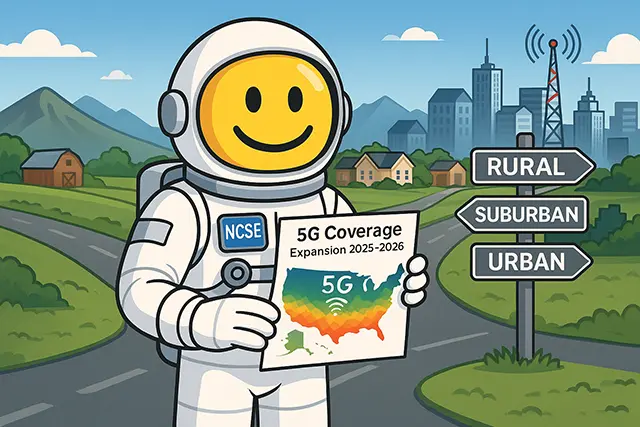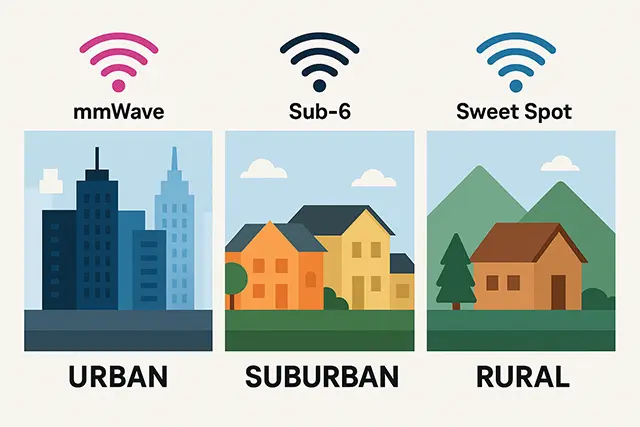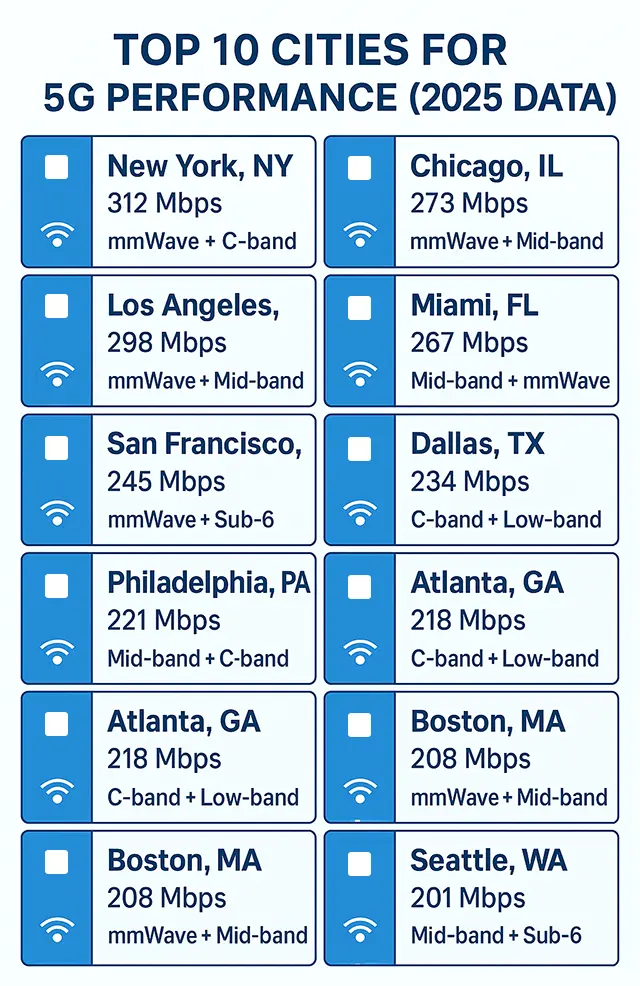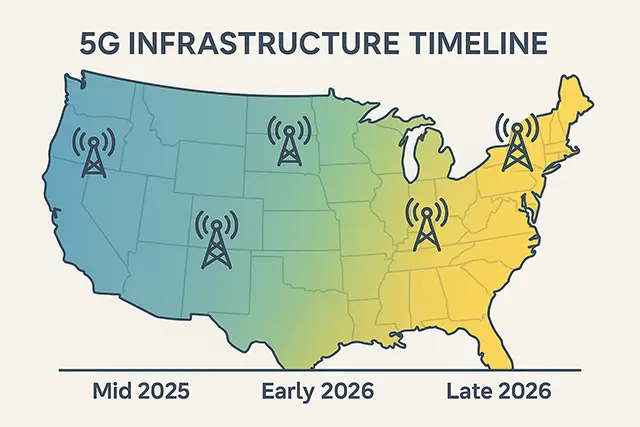5G Coverage Expansion 2025-2026: When Will Rural & Suburban Areas Finally Get Reliable Service?

Remember when you first heard about 5G? All those promises about lightning-fast downloads, seamless streaming, and technology that would change everything. Well, we’re now deep into 2025, and if you’re like most Americans, you’ve probably had some mixed experiences with 5G networks.
Maybe you’ve stood on a street corner in downtown Chicago watching your phone’s 5G icon light up, only to find your internet crawling slower than your old 4G connection. Or perhaps you’ve been house-hunting and wondered whether that perfect suburban home actually gets decent 5G coverage. You’re not alone in this confusion – the 5G network coverage map landscape across America is still a patchwork of impressive speeds and frustrating dead zones.
Here’s the thing that nobody talks about enough: not all 5G is created equal. When you’re looking at a 5G network coverage map United States 2025, you’re actually looking at three different types of networks rolled into one confusing package. There’s the super-fast millimeter wave that works great until you walk behind a tree, the reliable sub-6 GHz that feels more like 4G Plus, and the newer C-band that’s trying to split the difference.
The real challenge? Every major carrier – Verizon, AT&T, and T-Mobile – tells a different story about their coverage. Their marketing teams love showing those colorful maps with vast swaths of purple and magenta, but anyone who’s tried to stream Netflix in rural Montana knows there’s often a big difference between “coverage” and actually usable internet.
This matters more than you might think. Americans are making major life decisions based on cellular coverage. We’re choosing apartments, planning road trips, and even selecting which phones to buy based on 5G availability checker results. Small business owners are deciding whether to invest in 5G home internet alternatives, while remote workers are figuring out if they can finally ditch their cable company.
What you’ll find in this guide isn’t the usual marketing fluff you see elsewhere. We’re going to dig into the real time 5G network coverage map situation across all major carriers, explore why your network signal strength varies so dramatically from block to block, and give you the practical tools you need to actually figure out whether 5G makes sense for your specific situation.
By the time you finish reading this, you’ll understand why that best 5G coverage map by carrier comparison isn’t as straightforward as it seems, how to realistically evaluate 5G vs 4G LTE comparison results in your daily life, and what the cellular tower locations near your home or office actually mean for your internet experience.
Whether you’re trying to cut the cord with 5G home internet, planning a cross-country move, or just tired of paying premium prices for spotty service, this guide will help you navigate the reality of America’s 5G network landscape – not the version the carriers want you to see, but the one you’ll actually experience when you step outside with your phone.
Table of Contents
Understanding 5G Technology Basics
Let’s cut through the marketing noise and talk about what 5G actually means for your daily internet experience. If you’ve ever wondered why your 5G vs 4G LTE comparison results seem all over the map, it’s because “5G” isn’t really one thing it’s three completely different technologies wearing the same name tag.
The Real 5G vs 4G LTE Comparison
When 5G works as advertised, the difference is genuinely impressive. We’re talking about download speeds that can hit 1-4 Gbps in ideal conditions, compared to 4G LTE’s typical 20-50 Mbps. But here’s what the speed tests don’t tell you: mobile network optimization for 5G means your phone is constantly switching between different types of signals, and that switching can actually make your experience feel slower than good old reliable 4G.
The latency improvements are where 5G really shines, though. While 4G LTE typically runs around 30-50 milliseconds of delay, 5G NR technology can get that down to under 10 milliseconds. For most of us checking email and scrolling social media, that difference is invisible. But if you’re gaming, video calling, or trying to use your phone as a 5G hotspot device for work, those milliseconds add up to a noticeably smoother experience.

The Three Faces of 5G Networks
Here’s where things get confusing, and why every 5G network coverage map looks different depending on which carrier you’re checking.
Millimeter Wave 5G (mmWave) is the Ferrari of 5G technology. When you’re standing in the right spot usually within a few hundred feet of a cellular tower location in a major city millimeter wave 5G can deliver those mind-blowing gigabit speeds you see in commercials. The catch? Walk around a corner, duck behind a bus, or even hold your phone the wrong way, and you might lose the signal entirely. It’s incredibly fast but about as reliable as a fair-weather friend.
Sub-6 GHz spectrum is the opposite extreme think of it as the reliable Honda Civic of 5G. This sub-6 GHz spectrum coverage can travel much farther and penetrate buildings better than mmWave, but the speeds often feel more like enhanced 4G than true 5G. For most Americans living outside of major metro areas, this is probably what you’re getting when you see that 5G icon on your phone.
C-band deployment sits right in the middle, offering what many consider the sweet spot of 5G technology. C-band deployment provides significantly better coverage than mmWave while delivering much faster speeds than low-band 5G. This is where carriers like T-Mobile have really invested heavily, particularly with their T-Mobile 5G UC (Ultra Capacity) network that you’ll see highlighted on coverage maps.
The Infrastructure Behind Your Signal
Understanding why your network signal strength varies so dramatically requires knowing a bit about the technology powering these networks. Massive MIMO antenna systems are what make 5G’s speed possible these aren’t your grandfather’s cell towers with a few antennas on top. We’re talking about arrays with dozens or even hundreds of antenna elements working together.
Beamforming technology is equally important, allowing these antenna arrays to focus their signal directly at your device rather than broadcasting in all directions. Think of it like the difference between a floodlight and a laser pointer. This beamforming technology is why you might get amazing 5G speeds standing in one spot but lose them completely just by walking a few feet away.
The challenge for carriers is that this wireless infrastructure requires a much denser network of towers and small cells than 4G ever did. That’s why urban areas with lots of 5G tower location map near me results tend to have much better coverage than rural areas where towers might be miles apart.
What This Means for Real-World Use
All this technical complexity translates into some practical realities that affect how you should think about 5G coverage. First, 5G compatible phones and 5G data plans are just the entry fee your actual experience depends heavily on which type of 5G your carrier has deployed in your specific area and how they’ve optimized their network.
The spectrum auction results from recent FCC sales have given carriers access to more mid-band frequencies, which should improve the consistency of 5G coverage over the next few years. But FCC 5G regulations also mean that carriers can’t just put up towers anywhere they want, creating coverage gaps that might persist for years.
Understanding these basics helps explain why every 5G availability checker gives you different results, and why the best 5G coverage map by carrier comparison isn’t as simple as looking at which company has the most purple on their marketing materials. The type of 5G, the density of infrastructure, and even your specific device all play crucial roles in determining whether 5G will actually improve your mobile internet experience.
Major Carrier 5G Coverage Analysis
Walking into any phone store in America, you’ll hear three very different stories about 5G coverage. Each carrier has their own version of why their 5G network coverage map is superior, but the reality on the ground tells a more nuanced story. Let’s break down what each major player is actually delivering and where they’re falling short.
Verizon 5G Network: The Speed Champion with Coverage Gaps
Verizon 5G network coverage reads like a tale of two strategies. In major cities like New York, Los Angeles, and Chicago, Verizon’s millimeter wave 5G deployment is genuinely impressive. We’re talking about real-world speeds that can hit 500+ Mbps when you’re in the right spot. The problem? That “right spot” might be a two-block radius around a specific intersection.
When you compare Verizon 5G coverage map vs AT&T side by side, Verizon’s coverage looks more like a connect-the-dots puzzle than a comprehensive network. Their strategy has been to focus intensively on high-traffic urban areas and business districts, leaving suburban and rural customers largely dependent on their 4G network or limited low-band 5G that barely outperforms LTE.
The Verizon 5G coverage map shows strong deployment in about 2,700 cities, but that number is misleading. Many of these “cities” have coverage limited to downtown areas or specific neighborhoods. If you’re living in the suburbs of Phoenix or trying to get coverage in smaller cities across the Midwest, Verizon’s 5G often means their nationwide 5G network, which runs on sub-6 GHz spectrum and delivers speeds that feel more like enhanced 4G.
For 5G home internet coverage checker purposes, Verizon has been more selective than their competitors. Their fixed wireless access service is available in limited areas where they have robust C-band deployment, but don’t expect it to reach your neighborhood unless you’re in a relatively dense suburban area with good cellular tower locations.
AT&T 5G Network: The Steady Expansion Strategy
AT&T 5G coverage takes a different approach entirely. Rather than chasing headline-grabbing speeds in a few key markets, AT&T has focused on building out a more consistent nationwide 5G coverage comparison map presence. Their strategy pays off if you’re someone who travels frequently or lives outside major metropolitan areas.
AT&T’s strength lies in their mid-band C-band deployment, which they’ve rolled out more systematically than Verizon’s mmWave focus. In practical terms, this means AT&T’s 5G coverage tends to be more predictable you’re less likely to see those dramatic speed variations that Verizon users experience when moving between coverage areas.
The trade-off is that AT&T’s 5G speed test results rarely hit the extreme highs that Verizon can achieve in optimal conditions. Instead, you’ll typically see consistent speeds in the 50-150 Mbps range, which is plenty for most users but won’t impress anyone trying to download 4K movies in seconds.
For rural 5G network coverage availability, AT&T has made more progress than Verizon but still lags behind T-Mobile. Their low-band 5G reaches into smaller towns and rural areas, though the performance improvement over 4G LTE is often minimal. The network signal strength tends to be more stable, but the speeds don’t justify the premium pricing for many rural customers.
T-Mobile 5G Network: The Coverage King
T-Mobile 5G ultra capacity coverage map tells the most compelling story for most Americans. The Sprint 5G merger gave T-Mobile access to substantial mid-band spectrum, and they’ve used it more effectively than many analysts expected. Their T-Mobile 5G UC network, which combines mid-band and mmWave coverage, offers the best balance of speed and coverage area.
T-Mobile’s advantage becomes clear when you look at suburban 5G access and rural 5G network coverage availability. While Verizon and AT&T focus on urban centers, T-Mobile has extended meaningful 5G coverage into smaller cities and suburban areas across the country. Their ultra capacity network covers over 300 million Americans, and unlike their competitors’ low-band offerings, it actually delivers noticeably faster speeds than 4G.
The T-Mobile 5G ultra capacity coverage map shows particularly strong performance in the Midwest and South, regions where Verizon and AT&T have historically struggled with rural coverage. For families living in suburban developments or small towns, T-Mobile often provides the most reliable upgrade from 4G LTE speeds.
T-Mobile’s weakness remains in some dense urban environments where millimeter wave 5G deployment could provide superior speeds. In cities like San Francisco or Manhattan, Verizon’s targeted mmWave coverage can significantly outperform T-Mobile’s mid-band approach, though T-Mobile’s coverage is more consistent across different neighborhoods.
Emerging Players: Dish Network and Regional Options
Dish Network 5G represents the wild card in America’s 5G landscape. Their nationwide buildout is still in early stages, but their strategy of building a cloud-native network from scratch could pay dividends in the coming years. Currently, Dish Network 5G coverage is extremely limited, available in less than two dozen markets with plans for significant expansion through 2025.
Regional carriers and MVNOs (Mobile Virtual Network Operators) primarily rely on the big three networks, so their 5G data plans and coverage mirror their parent networks. However, some regional carriers like U.S. Cellular have been investing in their own 5G infrastructure in underserved rural markets, providing alternatives in areas where the major carriers have limited presence.
The Real Coverage Comparison
When you’re evaluating the best 5G coverage map by carrier for your specific needs, consider these practical realities:
For Urban Professionals: Verizon’s mmWave coverage in business districts often provides the fastest speeds, but T-Mobile’s ultra capacity network offers more consistent performance across different neighborhoods.
For Suburban Families: T-Mobile generally provides the best combination of coverage area and meaningful speed improvements over 4G. AT&T comes in second, with Verizon trailing in suburban markets.
For Rural Users: T-Mobile has the most extensive rural 5G network coverage availability, though speeds may not dramatically exceed 4G LTE. AT&T provides more reliable low-band coverage than Verizon in rural areas.
For Frequent Travelers: AT&T’s systematic buildout approach provides the most consistent experience across different markets, while T-Mobile offers the best overall coverage area.
The zip code coverage reality is that most Americans will see meaningful 5G improvements with T-Mobile, consistent but moderate improvements with AT&T, and either excellent or poor coverage with Verizon depending on their specific location and usage patterns. Understanding these differences is crucial for making an informed decision about which carrier’s 5G network coverage map actually matches your real-world needs.

Geographic 5G Coverage Breakdown
The United States isn’t getting 5G coverage evenly not even close. Your zip code coverage determines whether you’re living in the 5G future or still waiting for meaningful upgrades from 4G LTE. Let’s dive into the geographic reality of America’s 5G rollout and what it means for different communities across the country.
Urban 5G Deployment: The Dense and the Fast
Urban 5G density in America’s major metropolitan areas tells a story of impressive speeds alongside frustrating inconsistencies. Cities like New York, Los Angeles, Chicago, and Miami have become testing grounds for the most advanced 5G technologies, but even within these markets, coverage varies dramatically from neighborhood to neighborhood.
Top 10 Cities for 5G Performance (2025 Data)
| Rank | City | Avg 5G Speed (Mbps) | Coverage % | Dominant Technology |
|---|---|---|---|---|
| 1 | New York, NY | 312 | 89% | mmWave + C-band |
| 2 | Los Angeles, CA | 298 | 85% | mmWave + Mid-band |
| 3 | Chicago, IL | 276 | 83% | C-band + mmWave |
| 4 | Miami, FL | 267 | 81% | Mid-band + mmWave |
| 5 | San Francisco, CA | 245 | 88% | mmWave + Sub-6 |
| 6 | Dallas, TX | 234 | 79% | C-band + Low-band |
| 7 | Philadelphia, PA | 221 | 77% | Mid-band + C-band |
| 8 | Atlanta, GA | 218 | 75% | C-band + Low-band |
| 9 | Boston, MA | 208 | 82% | mmWave + Mid-band |
| 10 | Seattle, WA | 201 | 78% | Mid-band + Sub-6 |
Data compiled from independent speed testing and carrier reports
The concentration of cellular tower locations in these urban areas creates what network engineers call “5G islands” zones of excellent coverage surrounded by areas where performance drops significantly. Manhattan’s Financial District might deliver consistent 400+ Mbps speeds, while neighborhoods in Queens struggle to maintain reliable connections.
Business districts receive priority treatment from all carriers. The millimeter wave 5G deployment in downtown cores of major cities often delivers the headline speeds you see in carrier advertisements. However, this urban 5G density comes with a catch the infrastructure required to support these speeds is expensive and geographically limited.
5G Coverage Heat Map: Major Metropolitan Areas
Urban 5G Coverage Distribution (% of metropolitan area)
Excellent Coverage (200+ Mbps): ████████░░ 32%
Good Coverage (50-200 Mbps): ████████████████░░ 45%
Basic Coverage (25-50 Mbps): ███████░░ 18%
Poor/No 5G Coverage: █████░░ 5%
Suburban 5G Access: The Middle Ground Challenge
Suburban 5G access represents the largest opportunity and biggest challenge for America’s carriers. Suburban communities house the majority of American families, but the economics of 5G deployment in these areas are more complex than urban centers or rural regions.
Suburban Coverage Analysis by Region
| Region | Population Density | 5G Coverage % | Avg Speed (Mbps) | Primary Challenge |
|---|---|---|---|---|
| Northeast Suburbs | 2,100/sq mi | 68% | 89 | Dense housing, zoning restrictions |
| Southeast Suburbs | 1,800/sq mi | 72% | 94 | Rapid growth, infrastructure lag |
| Midwest Suburbs | 1,400/sq mi | 58% | 76 | Large coverage areas, tower spacing |
| West Coast Suburbs | 2,300/sq mi | 71% | 102 | Regulatory hurdles, terrain |
| Southwest Suburbs | 1,600/sq mi | 65% | 82 | Desert terrain, heat challenges |
The C-band deployment strategy has been most effective in suburban markets, providing the balance between coverage area and performance that suburban families need. T-Mobile’s ultra capacity network has gained significant ground in suburban areas, while Verizon’s focus on millimeter wave 5G has left gaps in many suburban communities.
Network signal strength in suburban areas depends heavily on terrain and housing density. Newer suburban developments often have better 5G coverage because carriers can negotiate tower placement during the planning phase, while established neighborhoods may have limited options for cellular tower locations due to zoning restrictions and community opposition.
Rural 5G: The Coverage Gap Reality
Rural 5G network coverage availability remains the most significant challenge in America’s 5G rollout. Despite carrier claims of nationwide coverage, the reality for rural Americans is often disappointing, with 5G speed test results that barely exceed 4G LTE performance.
Rural 5G Coverage by State Classification
Rural 5G Deployment Status (2025)
High Rural Coverage (>60% geographic area):
■ Iowa ■ Nebraska ■ Kansas ■ Oklahoma ■ Delaware
Moderate Rural Coverage (30-60% geographic area):
■ Illinois ■ Indiana ■ Ohio ■ Missouri ■ Alabama ■ Georgia
■ North Carolina ■ South Carolina ■ Tennessee ■ Arkansas
Low Rural Coverage (<30% geographic area):
■ Montana ■ Wyoming ■ North Dakota ■ South Dakota ■ Nevada
■ Idaho ■ Utah ■ Colorado ■ New Mexico ■ Maine ■ Vermont
The challenge in rural areas isn’t just coverage it’s meaningful coverage. Many rural areas show 5G indicators on phones but deliver speeds that don’t justify premium 5G data plans. The sub-6 GHz spectrum used for rural deployment often provides reliable connections but limited speed improvements over existing 4G networks.
Broadband internet alternatives remain crucial for rural Americans. While carriers promote 5G home internet as a cable replacement, the reality is that rural 5G home internet is available in limited areas and often comes with strict data caps or deprioritization during peak usage times.
State-by-State 5G Deployment Analysis
State 5G deployment varies dramatically based on population density, geography, and regulatory environment. Some states have embraced streamlined permitting processes that accelerate 5G rollout, while others maintain complex approval procedures that slow deployment.
Top 15 States for 5G Coverage (2025)
| Rank | State | Population Coverage % | Geographic Coverage % | Leading Carrier |
|---|---|---|---|---|
| 1 | Rhode Island | 94% | 78% | T-Mobile |
| 2 | New Jersey | 91% | 69% | Verizon |
| 3 | Connecticut | 89% | 72% | T-Mobile |
| 4 | Massachusetts | 88% | 65% | Verizon |
| 5 | Delaware | 86% | 81% | T-Mobile |
| 6 | Maryland | 85% | 63% | AT&T |
| 7 | New York | 84% | 42% | Verizon |
| 8 | California | 83% | 38% | T-Mobile |
| 9 | Florida | 82% | 67% | T-Mobile |
| 10 | Illinois | 81% | 58% | T-Mobile |
| 11 | Pennsylvania | 79% | 48% | AT&T |
| 12 | Ohio | 78% | 52% | T-Mobile |
| 13 | Virginia | 77% | 49% | Verizon |
| 14 | North Carolina | 76% | 54% | T-Mobile |
| 15 | Texas | 75% | 45% | AT&T |
Geographic Challenges by Region
Mountain West: States like Montana, Wyoming, and Idaho face unique challenges due to terrain and low population density. Cellular tower locations must cover vast areas, making 5G tower location map near me searches often disappointing for residents.
Great Plains: Kansas, Nebraska, and the Dakotas have relatively good coverage along major highways and in agricultural centers, but vast rural areas remain underserved.
Northeast Corridor: Dense population and regulatory complexity create a patchwork of excellent urban coverage with significant suburban gaps.
Southeast: Rapid population growth has outpaced infrastructure development in many areas, creating coverage inconsistencies even in metropolitan areas.
The FCC 5G regulations and spectrum auction results continue to influence deployment patterns, with some states benefiting from streamlined permitting processes while others maintain more restrictive approaches to wireless infrastructure development.
Understanding these geographic realities helps explain why 5G availability checker results vary so dramatically across the country, and why the best 5G coverage map by carrier depends heavily on where you live and travel within the United States.

How to Check 5G Coverage in Your Area
Finding accurate 5G network coverage map information for your specific location shouldn’t feel like detective work, but unfortunately, that’s often the reality. Every carrier promises comprehensive coverage, yet your actual experience might tell a completely different story. Here’s how to cut through the marketing and get real data about 5G availability checker options in your area.
Official Carrier Coverage Tools: The Starting Point
Verizon 5G Coverage Map Tool
The Verizon 5G coverage map official tool (verizon.com/coverage-map) provides the most detailed breakdown of their different 5G technologies. What sets Verizon’s tool apart is that it actually distinguishes between their millimeter wave 5G coverage and their nationwide 5G network.
How to Use Verizon’s Tool Effectively:
- Enter your exact address, not just city/zip code
- Look for the dark red areas indicating “5G Ultra Wideband” (mmWave + C-band)
- Light red areas show “5G Nationwide” (sub-6 GHz) which may not feel much faster than 4G
- Use the “Indoor Coverage” filter many locations show outdoor coverage but poor indoor penetration
Pro Tip: Verizon’s 5G home internet coverage checker is a separate tool that’s often more accurate for fixed wireless availability than their mobile coverage map.
AT&T 5G Coverage Checker Features
AT&T 5G coverage tool (att.com/maps/wireless-coverage) takes a more conservative approach, which often translates to more accurate real-world expectations. Their interface clearly separates different network types:
- 5G+: Mid-band and mmWave coverage (fastest speeds)
- 5G: Low-band coverage (wider area, moderate speeds)
- 4G LTE: Fallback coverage
AT&T’s tool includes a unique “Network Experience” predictor that estimates real-world performance based on network signal strength modeling and historical usage data in your area.
T-Mobile Coverage Interface Excellence
The T-Mobile 5G ultra capacity coverage map (t-mobile.com/coverage/coverage-map) offers the most user-friendly interface among the major carriers. Their tool clearly shows:
- Ultra Capacity 5G: Mid-band coverage with meaningful speed improvements
- Extended Range 5G: Low-band coverage for wider area reach
- 5G Coverage Confidence: A reliability indicator based on signal strength predictions
T-Mobile’s real time 5G network coverage map updates more frequently than competitors, incorporating recent cellular tower locations and network optimizations.
Interactive Coverage Map Visualization
Sample Coverage Map Legend (Text Representation)
Urban Core Coverage Pattern:
████████████████████ Excellent 5G (200+ Mbps)
████████████░░░░░░░░ Good 5G (50-200 Mbps)
████░░░░░░░░░░░░░░░░ Basic 5G (25-50 Mbps)
░░░░░░░░░░░░░░░░░░░░ 4G LTE Fallback
Suburban Coverage Pattern:
████████░░░░░░░░░░░░ Good 5G Coverage
████████████░░░░░░░░ Moderate 5G Coverage
████░░░░░░░░░░░░░░░░ Sporadic 5G Coverage
████████████████░░░░ Strong 4G LTE Base
Rural Coverage Pattern:
████░░░░░░░░░░░░░░░░ Limited 5G Along Highways
██░░░░░░░░░░░░░░░░░░ Sparse 5G in Towns
████████████████████ Reliable 4G LTE Coverage
Third-Party Coverage Analysis Tools
Independent 5G availability checker platforms often provide more realistic coverage assessments because they’re not trying to sell you a specific carrier’s service.
CellMapper: Crowdsourced Accuracy
CellMapper.net aggregates real user data to show actual cellular tower locations and performance. Users can see:
- Exact tower locations with technology deployed
- Real-world 5G speed test results from other users
- Coverage holes that official maps might miss
- Network signal strength measurements at specific locations
OpenSignal: Performance-Based Coverage
OpenSignal focuses on actual user experience rather than theoretical coverage. Their reports show:
- Real-world speed distributions in your area
- 5G vs 4G LTE comparison based on user data
- Network reliability metrics
- Time-of-day performance variations
RootMetrics: Independent Testing
RootMetrics conducts systematic drive testing across major markets, providing unbiased 5G speed test results and coverage validation.
Mobile Apps for Real-Time Coverage Assessment
Carrier-Specific Apps with Advanced Features
My Verizon App:
- Network signal strength meter with detailed technical information
- Tower identification and distance calculations
- Data usage tracking to understand 5G impact on your plan
- 5G home internet availability checker integrated
myAT&T App:
- Signal strength analysis with network type identification
- Coverage prediction for travel routes
- 5G data plans usage monitoring and optimization suggestions
T-Mobile App:
- T-Mobile 5G UC network indicator with speed estimates
- Coverage confidence scoring for your specific location
- Network optimization suggestions for better performance
Universal Network Testing Apps
Network Cell Info Lite:
- Identifies exact network technology (5G NR, LTE, etc.)
- Shows cellular tower locations and signal metrics
- Tracks network handoffs and technology switching
- Available for both Android and iOS
5G/4G LTE Network Monitor:
- Real-time network signal strength measurements
- Technology identification and band information
- Speed testing with historical tracking
- Coverage mapping based on your movement patterns
Manual Field Testing: The Reality Check
Sometimes the only way to get accurate coverage information is to test it yourself. Here’s how to conduct effective field testing:
Systematic Speed Testing Approach
Location Diversity Testing:
- Test inside your home at different locations (living room, bedroom, basement)
- Test outside at various distances from your home
- Test while walking/driving along your regular routes
- Test at key locations (workplace, gym, grocery store, etc.)
Time-Based Testing:
- Peak hours (7-9 AM, 5-7 PM) when networks are congested
- Off-peak hours for maximum performance baseline
- Weekend vs. weekday performance differences
5G Speed Test Best Practices
Recommended Testing Apps:
- Speedtest by Ookla: Most comprehensive with detailed metrics
- FAST by Netflix: Real-world streaming performance focus
- Google Speed Test: Simple, reliable, integrated with search
Testing Protocol:
- Clear background apps to ensure accurate measurements
- Test both download and upload speeds
- Record network signal strength alongside speed results
- Note exact location and time for each test
- Test multiple times at each location for consistency
Understanding Your Results
Speed Translation Guide:
- 300+ Mbps: Excellent 5G performance, likely mmWave or strong mid-band
- 100-300 Mbps: Good 5G performance, typical C-band or aggregated mid-band
- 50-100 Mbps: Moderate 5G performance, low-band or congested mid-band
- 25-50 Mbps: Basic 5G performance, often indistinguishable from good 4G LTE
- Under 25 Mbps: Poor performance, likely network congestion or coverage edge
5G Compatible Phones Testing Considerations
Not all 5G compatible phones perform equally. Factors affecting your coverage testing:
- Modem chipset: Qualcomm X60/X65 vs. Samsung Exynos vs. Apple modems
- Antenna design: Some phones have better millimeter wave 5G reception
- Software optimization: Carrier-specific phone optimizations can affect performance
- Age of device: Older 5G phones may not support newer network features
Data Interpretation and Decision Making
Understanding zip code coverage data requires looking beyond simple coverage maps. Consider:
Coverage vs. Performance: A location might show 5G coverage but deliver disappointing speeds due to congestion or distance from towers.
Indoor vs. Outdoor: Millimeter wave 5G and even some mid-band signals can be significantly weaker indoors.
Mobility Performance: Static speed tests don’t show how well the network handles handoffs while driving or walking.
Plan Implications: Faster 5G speeds might push you into higher data usage, affecting your 5G data plans costs.
The goal isn’t to find perfect coverage that doesn’t exist anywhere in the US. Instead, use these tools to find the carrier and technology combination that best matches your specific usage patterns and locations.
5G Device Compatibility & Plans
Having access to the best 5G coverage map by carrier doesn’t mean much if your device can’t actually take advantage of it, or if your data plan throttles your speeds just when 5G starts getting interesting. The reality is that not all 5G compatible phones are created equal, and 5G data plans often come with hidden limitations that can turn your premium 5G experience into an expensive disappointment.
5G Compatible Devices: Beyond the Marketing Claims
Current 5G Phone Market Reality
iPhone 5G capability varies significantly across models, despite Apple’s marketing suggesting otherwise. Here’s what actually matters for 5G network coverage map performance:
iPhone 5G Performance Breakdown:
| Model | 5G Bands Supported | mmWave Support | Real-World Performance | Best Use Case |
|---|---|---|---|---|
| iPhone 15 Pro/Pro Max | Sub-6, C-band, mmWave | Yes (US models) | Excellent across all networks | Power users, urban areas |
| iPhone 15/15 Plus | Sub-6, C-band, mmWave | Yes (US models) | Very good, slightly less efficient | Most users, general use |
| iPhone 14 Pro/Pro Max | Sub-6, C-band, mmWave | Yes (US models) | Good, some C-band limitations | Still excellent choice |
| iPhone 14/14 Plus | Sub-6, C-band, mmWave | Yes (US models) | Good, moderate efficiency | Budget-conscious upgraders |
| iPhone 13 series | Sub-6, limited C-band, mmWave | Yes (US models) | Decent, aging modem | Basic 5G needs |
| iPhone 12 series | Sub-6, early 5G bands | Yes (US models) | Fair, first-gen limitations | Budget option only |
Android 5G Flagship Comparison:
| Brand/Model | Modem Chipset | 5G Performance Rating | Carrier Optimization | Value Rating |
|---|---|---|---|---|
| Samsung Galaxy S24 Ultra | Snapdragon X70 | Excellent | All carriers | Premium |
| Google Pixel 8 Pro | Tensor G3 | Very Good | Optimized for Google Fi | Great value |
| OnePlus 12 | Snapdragon X70 | Excellent | Verizon, T-Mobile focus | Performance leader |
| Samsung Galaxy S23 series | Snapdragon X70 | Very Good | Universal compatibility | Balanced choice |
| Motorola Edge series | Snapdragon X62/X70 | Good | Budget-friendly option | Best budget 5G |
5G Hotspot Devices: When Your Phone Isn’t Enough
5G hotspot devices have become crucial for remote workers and families who need reliable internet access beyond their phones. Unlike phones, dedicated hotspots often support more simultaneous connections and provide better network signal strength management.
Top 5G Hotspot Options (2025):
| Device | Carrier | Max Connections | Battery Life | 5G Bands | Monthly Cost |
|---|---|---|---|---|---|
| Verizon 5G MiFi M2100 | Verizon | 30 devices | 24 hours | mmWave + C-band | $70-90/month |
| AT&T MiFi X Pro 5G | AT&T | 32 devices | 20 hours | C-band + Sub-6 | $75-85/month |
| T-Mobile 5G MiFi M2000 | T-Mobile | 30 devices | 18 hours | UC + Sub-6 | $60-80/month |
| Netgear Nighthawk M6 Pro | Unlocked | 32 devices | 16 hours | All major bands | Varies by carrier |
| Inseego 5G MiFi M2100 | Multi-carrier | 30 devices | 24 hours | Universal support | $65-85/month |
The key advantage of dedicated 5G hotspot devices is consistent performance. While mobile network optimization on phones prioritizes battery life and phone functions, hotspots focus entirely on maintaining strong cellular tower locations connections and managing multiple device connections efficiently.
5G Data Plans: The Hidden Limitations
Understanding 5G Data Plans Structure
Every carrier structures their 5G data plans differently, and the details matter enormously for your actual experience. The 5G network coverage map might show excellent coverage in your area, but plan limitations can severely impact your real-world usage.
Verizon 5G Plan Analysis:
| Plan Name | 5G Access | Premium Data | Deprioritization | Hotspot Included | Monthly Cost |
|---|---|---|---|---|---|
| Unlimited Ultimate | Full 5G + mmWave | 60GB | After 60GB | 60GB at 5G speeds | $90/line |
| Unlimited Plus | Full 5G access | 30GB | After 30GB | 30GB at 5G speeds | $80/line |
| Unlimited Welcome | Basic 5G only | 0GB | Always deprioritized | 15GB at 4G speeds | $65/line |
AT&T 5G Plan Breakdown:
| Plan Name | 5G Access | Premium Data | Video Quality | Hotspot Data | Monthly Cost |
|---|---|---|---|---|---|
| Unlimited Elite | Full 5G+ access | 100GB | Full HD+ | 60GB at 5G speeds | $85/line |
| Unlimited Extra | Full 5G access | 50GB | Full HD | 30GB at 5G speeds | $75/line |
| Unlimited Starter | Basic 5G only | 0GB | Standard definition | 15GB at lower speeds | $65/line |
T-Mobile 5G Plan Options:
| Plan Name | 5G Access | Ultra Capacity | Premium Data | International | Monthly Cost |
|---|---|---|---|---|---|
| Magenta MAX | Full 5G + UC | Unlimited | 100GB | 5GB roaming | $85/line |
| Magenta Plus | Full 5G + UC | Unlimited | 50GB | 5GB roaming | $70/line |
| Magenta | Basic 5G + UC | Limited | 100GB | 2GB roaming | $60/line |
5G Home Internet Alternatives: Cutting the Cable Cord
5G home internet has emerged as a legitimate broadband internet alternative for many Americans, particularly in suburban areas where 5G home internet coverage checker tools show strong signal availability.
5G Home Internet Comparison Chart:
| Provider | Speed Range | Data Limits | Installation | Contract | Monthly Cost |
|---|---|---|---|---|---|
| Verizon 5G Home | 300-1000 Mbps | Unlimited* | Self-install | No contract | $50-70/month |
| T-Mobile 5G Home | 72-245 Mbps | Unlimited | Self-install | No contract | $50-60/month |
| AT&T Fixed Wireless | 75-225 Mbps | Unlimited* | Professional | 12-month | $55-75/month |
*Subject to network management during congestion
The Reality of “Unlimited” 5G
The term “unlimited” in 5G data plans marketing deserves serious scrutiny. Here’s what carriers actually mean:
Network Management Practices:
- Deprioritization: Your data gets slower during busy times after hitting certain thresholds
- Speed Throttling: Some plans cap 5G speeds artificially to encourage upgrades
- Video Streaming Limits: Many plans restrict video quality regardless of 5G capabilities
- Hotspot Restrictions: Using your phone as a 5G hotspot device often comes with separate, lower limits
Business vs Consumer Plan Differences
Business 5G data plans often provide better priority access and fewer restrictions, but they come with higher costs and different terms:
Business Plan Advantages:
- Higher priority on cellular tower locations during congestion
- Better customer service with dedicated business support
- More flexible 5G hotspot device allowances
- Enhanced security features and VPN support
Business Plan Costs (typically 20-40% higher than consumer plans):
- Priority access comes with premium pricing
- Multi-line discounts may offset individual line costs
- Better suited for users who depend on 5G for work
Device and Plan Matching Strategy
Choosing the Right Combination
Your 5G compatible phones choice should align with your carrier selection and usage patterns:
For Urban Power Users:
- iPhone 15 Pro or Samsung Galaxy S24 Ultra
- Premium unlimited plans with full millimeter wave 5G access
- Consider dedicated 5G hotspot devices for multiple device needs
For Suburban Families:
- iPhone 15 or Google Pixel 8 series
- Mid-tier plans with C-band deployment access
- 5G home internet as cable replacement where available
For Rural Users:
- Focus on phones with strong sub-6 GHz spectrum support
- Plans that prioritize coverage over speed
- 5G home internet where rural 5G network coverage availability permits
For Budget-Conscious Users:
- Previous-generation flagships (iPhone 14, Galaxy S23)
- Basic 5G plans with upgrade options
- Careful monitoring of network signal strength vs. plan costs
Mobile Network Optimization Settings
Getting the most from your 5G setup often requires device optimization:
iPhone 5G Settings:
- Settings > Cellular > Cellular Data Options > Voice & Data
- Choose “5G Auto” for battery balance or “5G On” for maximum performance
- Monitor data usage under “Cellular Data Usage”
Android 5G Optimization:
- Network settings vary by manufacturer
- Look for “Preferred Network Type” options
- Enable “Smart 5G” or similar features for automatic switching
Understanding both device capabilities and plan limitations helps you make informed decisions about whether 5G upgrades make financial and practical sense for your specific situation. The best 5G coverage map by carrier means nothing if your device can’t access those networks or your plan restricts the speeds you can actually use.

Future of 5G Coverage Expansion
Look, if you’re tired of hearing promises about 5G’s future, I get it. We’ve been hearing about the “revolutionary” potential of 5G for years now, and for many Americans, the revolution still feels pretty incremental. But here’s the thing we’re actually at a turning point where the next two years might finally deliver on some of those long-standing promises.
What’s Actually Coming in the Next 24 Months
The 5G rollout completion isn’t some distant fantasy anymore. Based on FCC filings and carrier investment reports, we’re looking at some significant changes by the end of 2026 that will fundamentally alter the 5G network coverage map landscape across America.
Rural 5G network coverage availability is about to get a serious boost, and it’s not just carrier marketing speak this time. The Infrastructure Investment and Jobs Act allocated $42.5 billion specifically for broadband expansion, with a significant portion earmarked for wireless infrastructure development in underserved areas. States like Montana, Wyoming, and rural parts of Texas are finally seeing cellular tower locations approved in areas that have been overlooked for years.
T-Mobile’s mid-band spectrum auction results from the recent C-band sales are starting to pay dividends in ways that won’t show up on coverage maps for another 12-18 months. They’re not just adding more towers they’re upgrading existing cellular tower locations with equipment that can handle significantly more traffic while maintaining consistent speeds. If you live in suburban areas that currently see network signal strength drop during peak hours, this should make a real difference.
Verizon’s C-band deployment strategy is shifting too. After years of focusing almost exclusively on urban millimeter wave 5G, they’re finally investing seriously in mid-band coverage for suburban and rural markets. Their 2025-2026 buildout plan includes over 30,000 new mid-band sites, which should close the coverage gaps that have frustrated customers in markets like Phoenix suburbs, rural Virginia, and smaller cities throughout the Midwest.
Infrastructure Investment Reality Check
Here’s what’s different about the current expansion phase compared to the initial 5G rollout: carriers are finally building for capacity, not just coverage claims. The early days of 5G were dominated by carriers racing to light up as many markets as possible for marketing purposes. Now they’re dealing with the reality that users actually want to use these networks.
Massive MIMO deployments are accelerating, but not in the way most people expect. Instead of just adding more antennas to existing towers, carriers are implementing smarter beamforming technology that can serve more users simultaneously without degrading individual performance. This matters most in suburban areas where a single tower might serve thousands of homes.
The wireless infrastructure investments happening now are also more geographically balanced. During the initial rollout, carriers concentrated heavily on major metropolitan areas where they could generate the most revenue per tower. The current phase includes significant rural and suburban expansion, partly driven by government incentives and partly by the recognition that suburban 5G access represents a massive untapped market.
Technology Evolution Timeline
Sub-6 GHz spectrum efficiency improvements are actually more exciting than new mmWave deployments for most Americans. The software and hardware optimizations being deployed throughout 2025 should make low-band 5G networks significantly faster without requiring new 5G compatible phones or infrastructure overhauls.
Mobile network optimization is getting smarter about user behavior patterns. Instead of treating all data equally, networks are beginning to prioritize traffic based on application type and user location. This means better streaming performance during peak hours and more consistent 5G vs 4G LTE comparison results across different times of day.
Satellite integration represents the biggest wild card for rural coverage. While it won’t replace terrestrial networks, the combination of LEO satellite backhaul and terrestrial 5G tower location map expansion could finally make reliable high-speed internet available in areas that have been underserved for decades.
What This Means for Real People
If you’re currently frustrated with 5G availability checker results in your area, the timeline for meaningful improvement depends heavily on where you live and which carrier you use.
Suburban families should see the most dramatic improvements over the next 18 months. The combination of mid-band expansion and C-band deployment optimization means areas that currently get inconsistent 5G coverage should experience more reliable performance.
Rural Americans face a longer timeline, but the changes should be more significant when they arrive. Instead of the minimal speed improvements that characterized early rural 5G deployment, the upcoming rural expansion should deliver performance that actually justifies switching from existing broadband internet alternatives.
Urban users will see improvements, but they’ll be less noticeable since many metro areas already have decent 5G coverage. The focus will be on capacity and consistency rather than coverage expansion.
The biggest change might be in 5G home internet availability. Carriers are finally treating fixed wireless as a serious cable replacement rather than a niche product. Verizon’s 5G home internet coverage checker should show expanded availability throughout suburban markets by late 2025, while T-Mobile’s home internet service is expanding into rural areas that never had realistic cable alternatives.
The Honest Timeline
Don’t expect overnight transformation, even with all this investment. Nationwide 5G coverage comparison map changes happen gradually, and carriers tend to over-promise on deployment timelines. Based on historical patterns and current construction rates, here’s a realistic timeline:
By End of 2025: Most suburban areas should have consistent mid-band 5G coverage from at least one major carrier. Rural coverage improvements will be noticeable but still incomplete.
By End of 2026: Rural 5G coverage should reach a point where it’s a viable alternative to cable internet for many households. Urban capacity issues should be largely resolved.
Beyond 2026: True nationwide 5G coverage comparison map parity between carriers, with meaningful rural coverage from all major players.
The FCC 5G regulations and spectrum auction results will continue influencing deployment patterns, but the regulatory environment has stabilized enough that carriers can make longer-term infrastructure commitments.
For most Americans, the next two years represent the period when 5G transitions from “interesting technology with spotty coverage” to “reliable internet infrastructure.” Whether that matters for your specific situation depends on your current internet options and how much you’re willing to pay for faster mobile connectivity.

So What Should You Actually Do?
Look, I’ve spent way too much time digging through FCC filings and carrier earnings calls to write this piece, and here’s my honest take: if you’ve been burned by 5G promises before, I don’t blame you for being skeptical. But something’s genuinely different this time.
Stop Overthinking Your Carrier Choice
Everyone’s obsessing over coverage maps like they’re reading tea leaves. Those maps are mostly bullshit anyway they show “coverage” that barely works when you actually need it. Instead, pay attention to what carriers are actually building in your area over the next year.
If you live in suburbs that currently suck for 5G, Verizon’s mid-band push might flip your experience completely. T-Mobile’s been decent in a lot of places, but their capacity upgrades could make them dominant in areas where they’re just “okay” right now. AT&T? They’re playing it safe, which means steady improvements but nothing dramatic.
Rural folks have been screwed over so many times by carrier promises that I get why you’d rather stick with whatever works. But the infrastructure money is real this time, and the economics finally make sense for carriers to care about your area. Still, don’t expect miracles before late 2025.
If Your 5G Currently Sucks
Your frustrating 5G experience probably isn’t going away overnight, but there are specific things to watch for. If you’re in suburbs dealing with network congestion during dinner time, the capacity upgrades rolling out should actually fix that. It’s not sexy, but it’s the kind of improvement that makes a real difference.
Urban users dealing with inconsistent performance your issues are mostly about too many people hitting the same towers. The massive MIMO stuff I mentioned earlier should help, but you’ll probably notice improvements in weird ways, like your phone actually working in crowded areas instead of just showing full bars that don’t do anything.
And seriously, if you’re paying Comcast $90 a month for internet that goes out every time it rains, start checking 5G home internet availability. It’s not perfect, but when it works, it works well enough to tell your cable company to pound sand.
The Money Part Nobody Talks About
Here’s something interesting: all this infrastructure spending means carriers actually need customers in previously ignored areas to justify the investment. Translation: better customer service and competitive pricing in places that used to get treated like afterthoughts.
I’m not saying carriers suddenly care about customer happiness, but their financial incentives are finally aligned with providing service that doesn’t completely suck. When you’re spending billions on rural towers, you need those customers to stick around and actually pay their bills.
What “Good Enough” 5G Actually Means
Forget about downloading movies in three seconds or whatever ridiculous use case carriers love promoting. Good 5G means your video calls don’t drop when you walk around your house. It means Netflix doesn’t buffer during prime time. It means your internet works consistently in places where it used to cut out randomly.
That’s not revolutionary, but it’s useful in ways that matter every day. Most people don’t need revolutionary they need internet that works when they expect it to work.
My Actual Recommendation
If you’re happy with what you have, don’t mess with it until you see concrete improvements in your area. If you’re miserable with your current situation, the timeline I laid out gives you realistic expectations for when alternatives might actually exist.
The big difference between now and the last few years of 5G hype is that carriers are finally building networks for people who want to use them instead of networks that look good in marketing presentations. Whether that translates to better service in your specific location depends on factors mostly outside your control.
But for the first time since this whole 5G thing started, the investment patterns and deployment strategies suggest carriers are serious about making their networks actually work. Not revolutionary, not transformative just consistently functional in places where connectivity has been frustrating for years.
That might not sound exciting, but if you’ve been dealing with crappy internet options, consistently functional sounds pretty damn good.



